Using your shop’s Cost of Doing Business (CODB) as a baseline for labor rates.
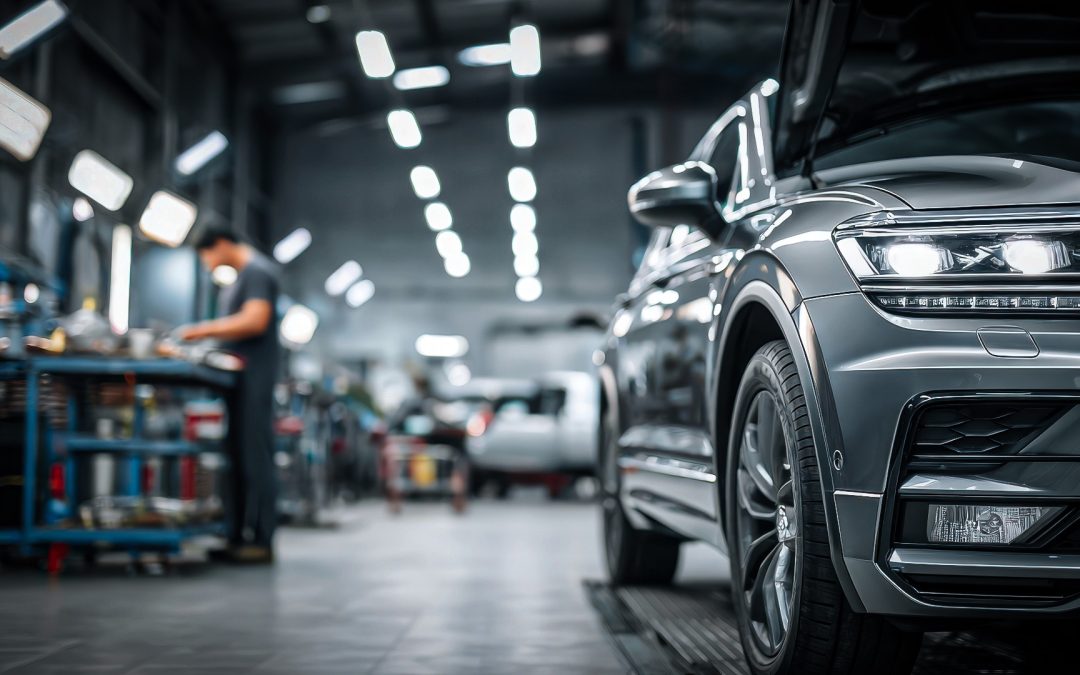
In Part 1 of this piece, I traced the history of the U.S. presidential state car from the beginning to the Kennedy Lincoln Continental. In this part, I’ll pick up with President Lyndon Baines Johnson’s state car and continue to the present day.
Although “concerns for protocol and safety” led to LBJ eventually getting a black 1967 Lincoln Continental as his state vehicle, he actually preferred white convertible Lincolns. Ford leased the hardtop Continental to the federal government for $1 a year. The 11,000-pound vehicle’s 340 horsepower V8 enabled it to reach speeds of over 100 miles per hour, despite the addition of 4,000 pounds of armor and “a bubble top thicker than the protective cockpit of an F-16 fighter” according to a Los Angeles Times article. This vehicle served Presidents Nixon, Ford, and Carter and traveled to 32 nations until being retired in the mid-to-late 1970s.
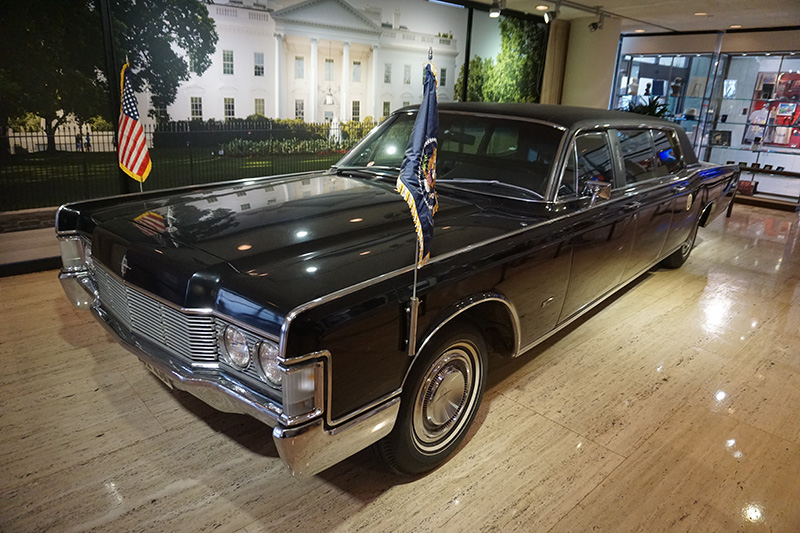
President Richard Nixon received a customized 22-foot, 13,000-pound 1972 Lincoln Continental in 1974. The White House leased the six-passenger limousine from Ford for $5,000 a year. A 460-cubic-inch, 214-horsepower V8, complete armor plate, bulletproof glass, racks for the Secret Service to store submachine guns, and external microphones to enable passengers to hear outside disturbances were all features of the fully outfitted vehicle. Presidents Nixon, Ford, Carter, Reagan, and George H. W. Bush all used this evolution of “Stagecoach.” It was the car that Ford was in when Sara Jane Moore attempted to assassinate him in 1975.
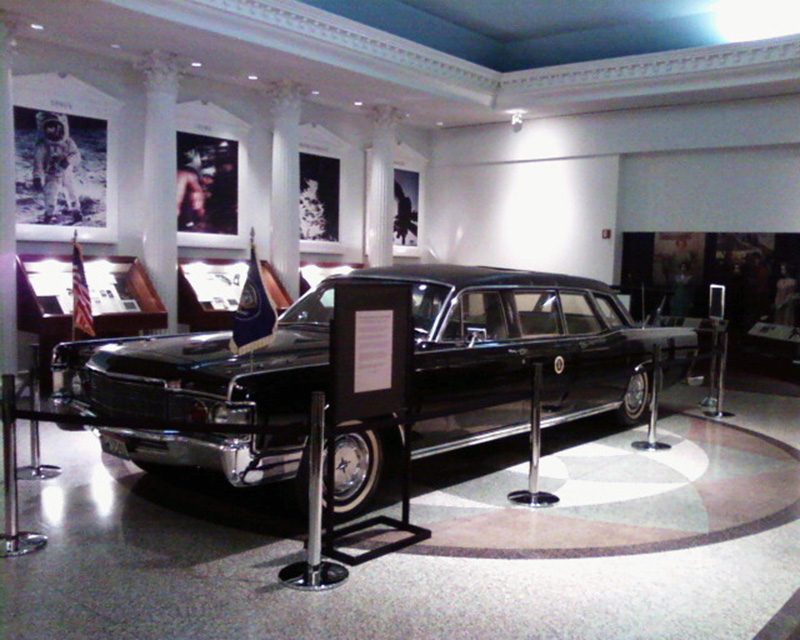
The last two of six bullets fired during the March 1981 attempt on Ronald Reagan’s life struck the limousine, damaging the bulletproof window of the right rear passenger door and bouncing off the rear-right quarter panel before hitting the president. The vehicle then took Reagan to George Washington University Hospital. After the 1981 shooting, the car was returned to Ford for a 1979 Lincoln grille, fresh interior, and front sheet metal (and presumably a little window repair and some bodywork). The 1972 limo had 40,617 miles on the odometer when it was taken out of service in 1992

The next presidential state car, a 1983 Cadillac, was delivered to President Reagan on January 30, 1984. Compared to the ordinary Fleetwood, this Cadillac was three inches higher and 17 inches longer. In addition to having the now-requisite armor and bulletproof glass, it was described as “distinctively styled, with a raised roof and a large rear greenhouse.” To counterbalance the weight of the armor, the car included larger tires and wheels, an automatic leveling system, and upgraded brakes.
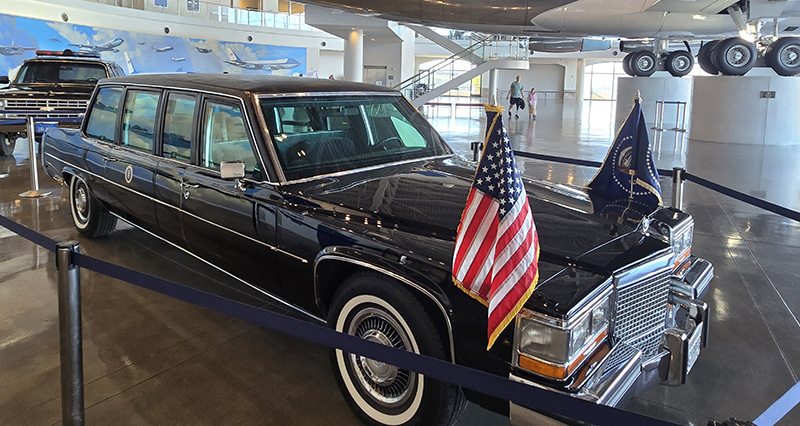
George Bush rode to his inauguration in January 1989 in a brand-new Lincoln Town Car. Although it had been delivered a few months earlier to President Reagan and President-elect Bush at the White House, it wasn’t officially used until Bush’s inauguration. While it started out as a stock Town Car, it was disassembled and completely rebuilt. The wheelbase was increased by 44.7 inches, and the overall length was increased to 263.7 inches. Just for reference, that’s a bit shy of 22 feet. That makes this limo as long as some box trucks.
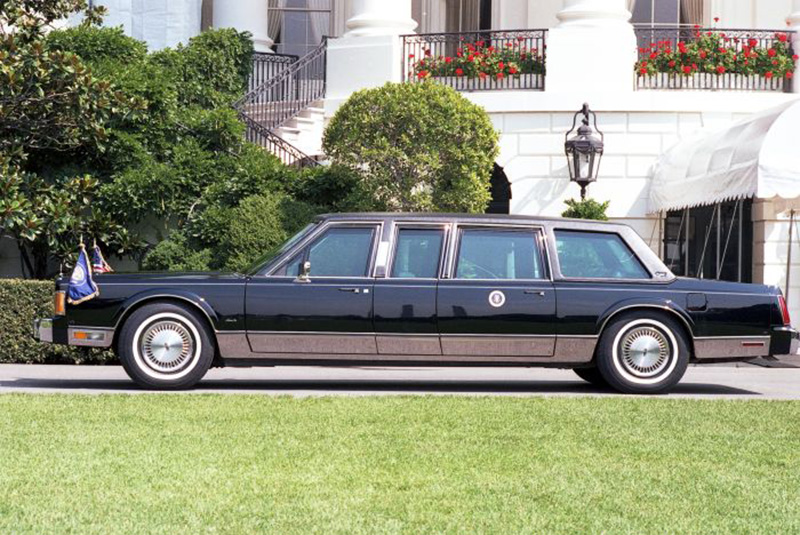
President Bill Clinton had three 1993 Cadillac Fleetwoods as his official state cars. With all of its doors locked to the public, one of those cars is presently on exhibit at the Clinton Presidential Center in Little Rock, Arkansas. Per Christine Mouw, museum curator, the museum can “dust the outside of the car, but if we needed to get inside it, we would have to contact the regional Secret Service office.”
In a very rare occurrence, just this past January, another one of his Cadillac Fleetwoods was auctioned off to the general public for over $264,000. The third vehicle is still owned by the CIA.
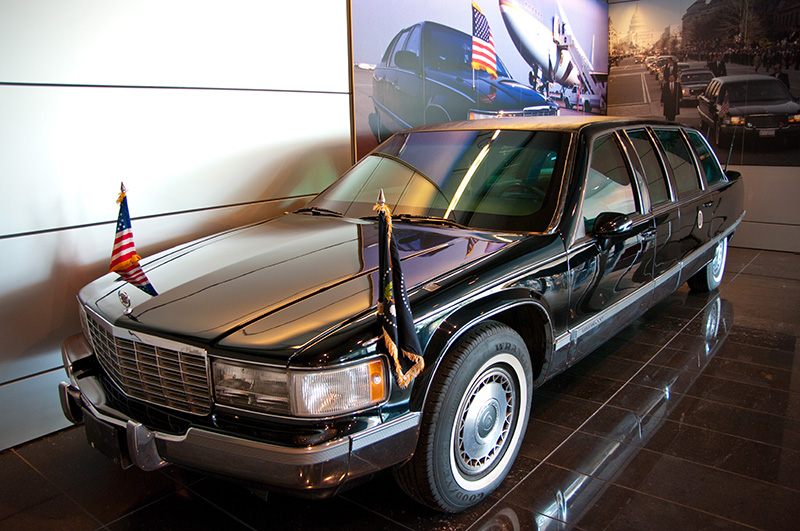
Cadillac no longer manufactured a vehicle that could be converted into a presidential limousine for George W. Bush’s first inauguration in 2001. Previous presidential limousines were stock vehicles that were modified by the Secret Service with state-of-the-art upgrades and security devices. Over time, the Secret Service’s requirements for armor and other features began to overtax the stock vehicle platforms, which led to short-lived brakes and malfunctioning transmissions. Instead, according to AutoWeek, “an R&D arm of General Motors in Detroit” created the George W. Bush state automobile from scratch to satisfy Secret Service requirements. The moniker “The Beast” was given to Bush’s state vehicle and continues to be used for presidential cars to this day.
In the 21st century, specific information on the presidential state car has been closely guarded. Well-informed conjecture theorized that President George W. Bush’s Cadillac Deville was built on the chassis of General Motors’ full-size sport utility vehicles. In addition to five-inch armored doors, this “Deville” included “bulletproof glass so thick it blocks out parts of the light spectrum,” according to Popular Mechanics. The car had run-flat tires, enclosed passenger compartments with their own air supplies, a 454 cubic inch truck engine, and a curb weight estimated at 14,000 pounds.
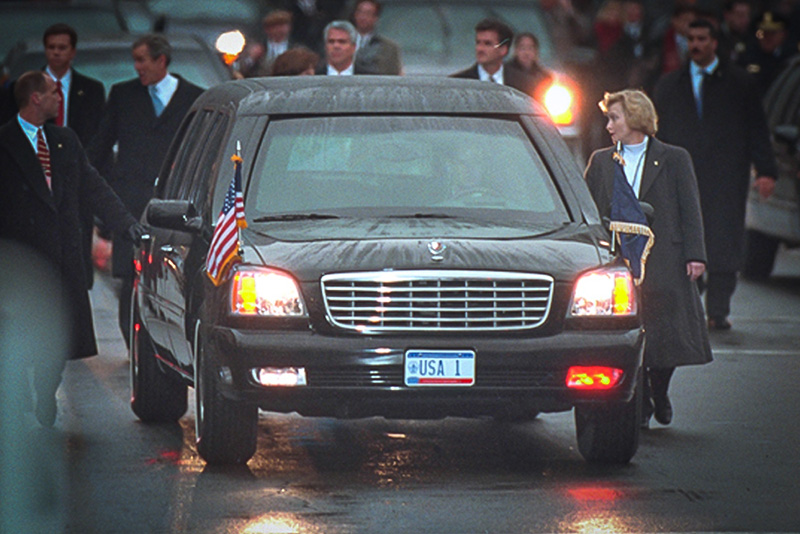
President Obama traveled the two miles down Pennsylvania Avenue from his first inauguration to the inaugural parade in the 2009 presidential state automobile, which was put into service that day. This “Cadillac” was not based on any specific model, although, according to CNET’s “Road/Show” blog, it had the “dual-textured grille and the dinner plate-sized Cadillac coat-of-arms badge” that were typical of the Cadillac CTS and Cadillac Escalade. However, it used the same headlights and taillights as other Cadillac production cars.
According to Antuan Goodwin of “Road/Show,” there were claims that the presidential state car was constructed on the chassis of a GMC TopKick. Goodwin believed the vehicle had either a Duramax 6.6-liter turbo V8 diesel engine or an 8.1-liter Vortec V8 gasoline engine. A later article in Autoweek suggested a gasoline engine, which means this generation of POTUSmobile likely shared its architecture and powerplant with rugged work vehicles and armored trucks.
Since this vehicle was equipped with Goodyear Regional RHS tires, which are normally used for medium- and heavy-duty trucks, the vehicle was believed to weigh between 15,000 and 20,000 pounds. The car’s weight limited its speed to around 60 mph and its fuel economy to 3.7 to 8 miles per gallon. The limousine was reported to have cost upwards of $300,000.
Compared to the previous model, five-inch bulletproof glass covered more of the vehicle. Additionally, it included run-flat tires and a fully sealed interior to safeguard its occupants in the case of a chemical assault. Eight-inch doors, pump-action shotguns, an armored fuel tank with foam to prevent explosion, onboard oxygen tanks, night vision glasses, and a tear gas cannon were all features of the 2009 presidential state car model.
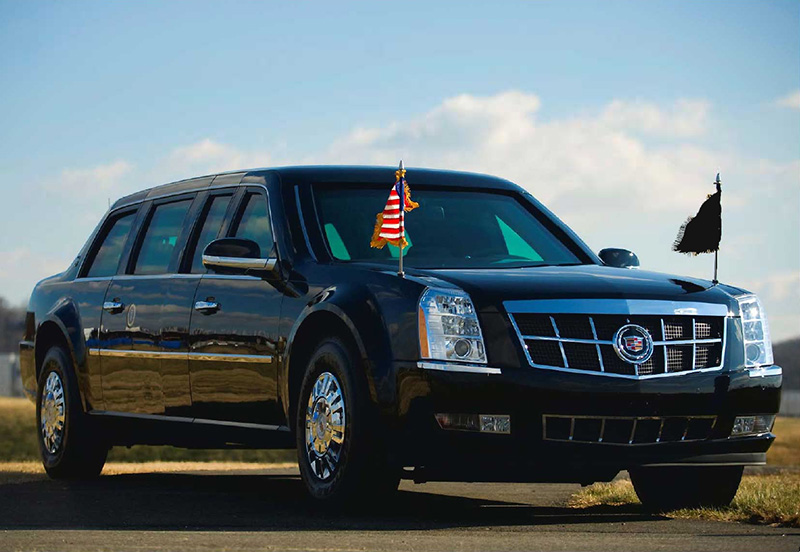
In 2014, General Motors was given three contracts for the new limousine by the Secret Service. The estimated cost of each state vehicle was between $1 and 1.5 million. President Trump’s visit to New York City on September 24, 2018, marked the debut of the current model.
“The design appears to be a simple evolution of the old model with more current Cadillac design cues, like an Escalade sedan,” according to Road & Track, which also estimated that the state vehicle weighs fifteen to twenty thousand pounds. According to NBC News, the limousine could accommodate seven people and was designed to mimic the Cadillac XT6’s appearance. Car and Driver stated that the vehicle was constructed on the GMC TopKick chassis and featured the Cadillac Escalade’s headlights and grille, which are characteristics of the Cadillac Escalade concept car. “The Beast” stands about six feet tall.
According to NBC, this presidential limo carries blood reserves of the president’s type for medical emergencies as well as the most advanced defensive features to date on a presidential ride. In addition to run-flat tires, night-vision equipment, smoke screens, and oil slicks for deterrents against intruders, the vehicle is hermetically sealed against chemical attacks. The vehicle is armored with steel, ceramic, and aluminum; its outside panels are eight inches thick; its windows are five inches thick; and its door handles may be electrified to prevent entry.
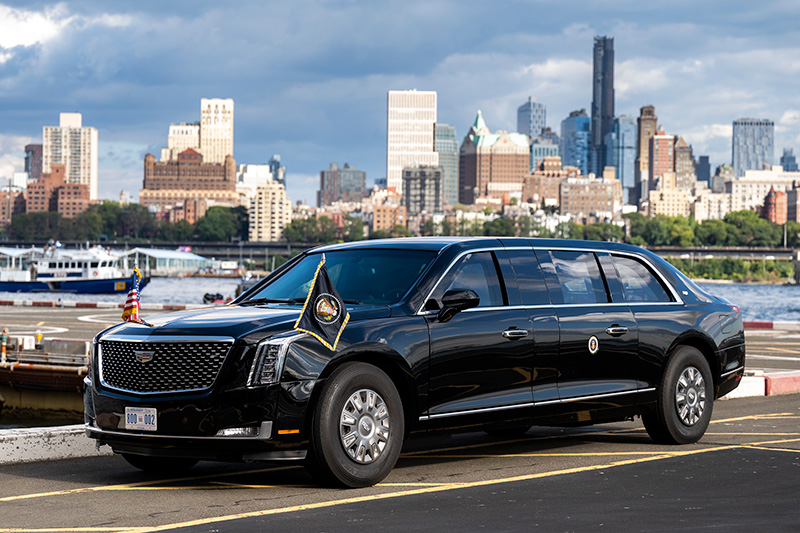
According to the article “Cars of the Presidents” in the January 1993 issue of Popular Mechanics, the United States Secret Service began to take part in the demolition of the presidential state automobile after its useful life was up, starting in the late 20th century. Federal agents use explosive rounds and bullets to destroy the car for two reasons. The first is to demonstrate how durable the car is against such weapons, and the second is to destroy the car and the secrets of its armoring, defenses, and manufacturing.
While presidential cars often look like standard models with a little “limo and lift” treatment, each iteration is increasingly bespoke and complex. One of the most unique aspects of presidential cars is that they are frequently seen but rarely explained. As for the folks who build these cars, that’s an incredible opportunity that also happens to come with an unbelievable amount of responsibility.
The articles and other content contained on this site may contain links to third party websites. By clicking them, you consent to Dorman’s Website Use Agreement.
Participation in this forum is subject to Dorman’s Website Terms & Conditions. Please read our Comment Policy before commenting.